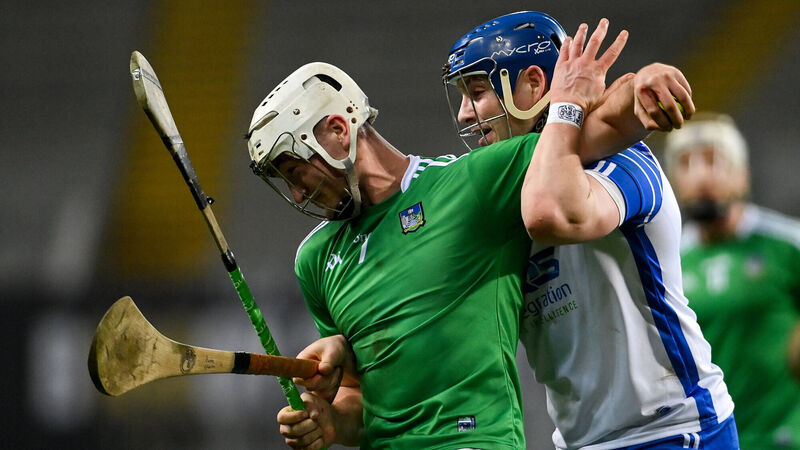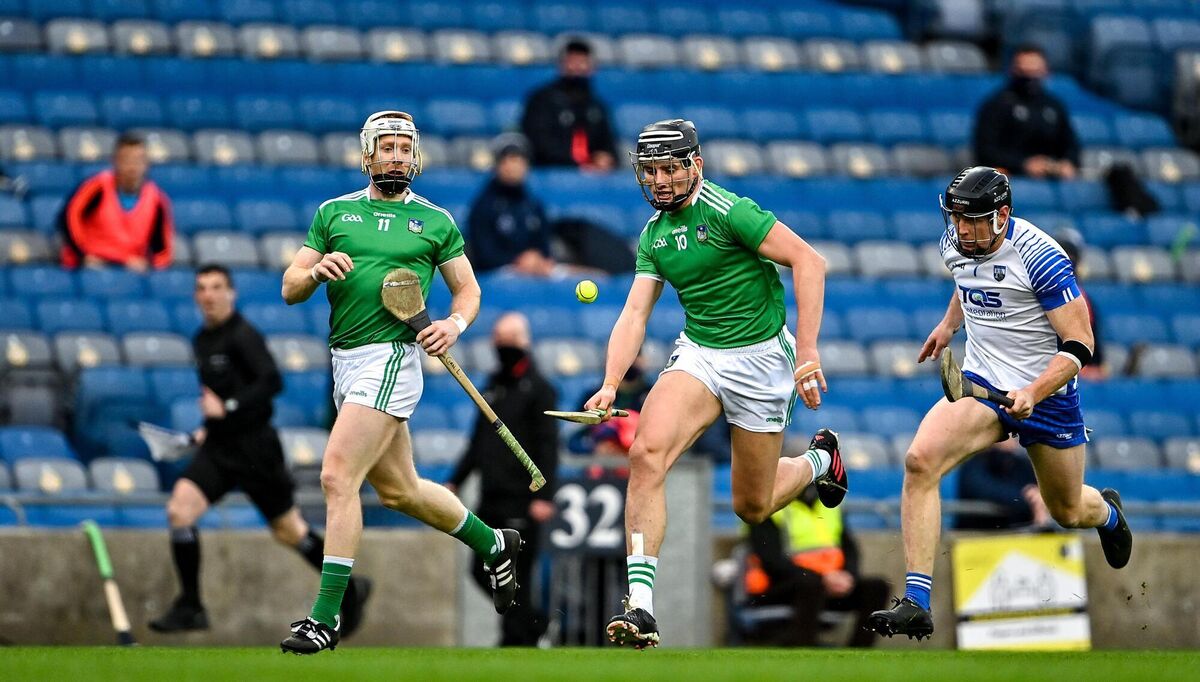Enda McEvoy: Righting the wrongs of 2019 never looked to good

Kyle Hayes of Limerick is tackled by Austin Gleeson of Waterford during the All-Ireland SHC final. Picture: Ramsey Cardy/Sportsfile
Apologies for the obvious question, which you were doubtless pondering yourself at teatime yesterday, but it has to be asked and an attempt has to be made to answer it.
Would Limerick be going for a four-in-a-row in 2021 if they hadn’t blown it against Kilkenny last year?
The kneejerk response is to say yes, of course they would be.
They’re that big, that athletic, that good. That well organised, that well-coached, that thoughtful in each sector of the pitch. That remorseless, that cyborg-y, that Terminator-ish. I’ll be back indeed – and you know they will be. They may not be a team for all times but they’re a team for our times.
A more nuanced view to take is that the ceist is, unfortunately, unanswerable, albeit no less fun to play around with for all that. The paths of victory do not run in straight lines. Defeat necessitates detours. Detours can be journeys of discovery.
An obvious touchstone. If Kilkenny hadn’t been surprised by Galway in 2001, would they have gone on to capture the next two All-Irelands? Scarcely. Instead, they ingested an unpleasant lesson, stored the pain and used it as fuel.
Another point of reference which springs equally speedily to mind: if Cork hadn’t lost narrowly to Kilkenny in 2003, would they have gone on to capture the next two All Irelands? Scarcely. Instead they etc.
Why should it have been any different with Limerick? What hurts instructs.
The losing of the 2019 All-Ireland semi-final was the winning of the 2020 All-Ireland. We can say this with certainty because that’s the way it unfolded.
For John Kiely and his troops the lessons of that black day at Croke Park were short and brutish.
First, don’t allow the other crowd to bomb out of the traps (granted, the MacCarthy Cup holders weren’t helped by the four-week hiatus since the Munster final, circumstances that didn’t obtain this time around). Secondly, be wiser in selecting one’s shots and be more accurate when pulling the trigger.
Simple lessons? Yes. Putting simple lessons into practice? Not so easy. Yet Limerick made the process of righting the wrongs of 2019 look inevitable, a feat of cogent thinking and good organisation in itself.
Like all really good teams the new champions think their way around the field so well. They may be predictable, at any rate insofar as nothing they do comes as a surprise to the spectator, but they are not one-dimensional.
They can go long, and when Nickie Quaid – so assured in his domestic duties yesterday; only the very best goalies turn tricky shots into routine saves – did that the half-forward line cleaned out Waterford under the dropping ball. As did the Limerick half-back line the Deise half-forwards when Stephen O’Keeffe deposited his puck-outs in that zone.
They can also go short, playing their way out of defence with all the haste of an elderly gentleman taking a Sunday stroll, spinning latticeworks of passes together off the stick. The receiver is always in the right position facing the right way; the pass is always, or nearly always, played at the right pace and angle; and the sliotar always adheres.
Barry Nash up the line to Kyle Hayes, then the defence-splitting diagonal across the field to Aaron Gillane, was a popular ploy. Another item for the collection arrived early in the second half when Sean Finn swept Dessie Hutchinson aside and offloaded to Gearoid Hegarty, who did what Hegarty does. Into the hand and boom.

Gearoid Hrubesch, rather. The man they call the monster. As for Kyle Hayes, a truly frightening proposition as a wing-back, one presumes Hollywood will be on to him to audition the next time they get around to doing a remake of Robocop.
Hutchinson is in his rookie season as an inter-county player and has acquitted himself splendidly. But Finn has been doing this for years and knows Hegarty will come short to offer himself. And if he doesn’t, Cian Lynch – more a midfielder here than a centre-forward – will do so. And if he doesn’t, well, there’s always Declan Hannon as a safe outlet in space in the middle.
It was reasonable to infer beforehand that Limerick had been saving their petrol for the big day. Having a Munster quarter-final, and therefore an extra fixture compared to most of their rivals, required them to calibrate their training schedule differently.
Be ready for Clare the first day out. Flick every dial up a notch for Tipperary. Bring them down a little, but not too much, for the Munster final. Up again half a notch for Galway. Still something in the tank? Great. Now hit it.
The assuredness the winners demonstrated in the opening quarter yesterday proved Paul Kinnerk and his chums had done the job brilliantly.
Ditto for the calmness, a near-insouciance that never threatened to spill over into arrogance or self-indulgence, with which they saw out the closing stages. Far from feeling the effects of a demanding campaign, still less dying on their feet, Limerick continued to chug away, piling up the sub three-minute miles. These things don’t come about by accident.
If Waterford found themselves reduced to punching above their weight, no matter. Everyone who faces John Kiely’s Limerick finds themselves reduced to punching above their weight. The underdogs had come further than they might have come and in the event fared about as well as they were entitled to.
Nor should it be forgotten that they’d undergone a huge degree of churn since their last appearance in the final. By and large it wasn’t positive churn, a statement that is not made with the benefit of hindsight. Imagine Noel Connors, Brick Walsh, Darragh Fives and the Mahonys in their prime there yesterday.
They were near enough at half-time if good enough. But it was the biggest certainty going that they weren’t going to be allowed waltz their way through the green curtain as easily as they did against Kilkenny.
Stephen Bennett’s goal a fortnight ago occurred with five men in striped shirts in the vicinity, none of whom laid a hand on him. It came as no surprise, then, that it took nearly an hour here for Calum Lyons, one of Waterford’s chief offensive weapons all championship, to wangle his way up the field and within sufficient range to uncork a shot that forced Quaid to make a sharp save.
Some other observations.
Forced to subsist on scraps, Austin Gleeson did a manful and mature job.
In view of Limerick’s lock on possession their tally of 11 wides was modest.
In passing, their superiority said a lot about Kilkenny, none of it even vaguely flattering. Then again, the only scenario worse for Kilkenny than losing to Waterford would have been beating Waterford.
Not that Brian Cody was the only person who dodged a bullet. One can imagine Tipp folk going to bed last night once more giving thanks for the fact that it wasn’t Limerick they had to face in last year’s final.
One of the reasons the men in green are champions again is because they didn’t return to the table with quite the same hand. Hayes to left-half back, Lynch to number 11, the reconstruction work on the full-back line triggered by the injuries to Mike Casey and Richie English. Partly because they had to, partly because they wanted to, Limerick evolved.
For 2021 they could do with finding someone who can cast spells inside the opposition’s 45-metre line. That said, Seamus Flanagan - so good against Galway in 2018 and again yesterday - furnishes them with a husky presence on the left-hand side of the field closer to the posts than Hegarty and Tom Morrissey operate.
Imagine this Limerick team scoring two goals a game. Eeek.
No four in a row attempt for them, then. But – and here’s an expression you’ve surely never heard before - two out of three ain’t bad. And that will do quite nicely for the moment.








